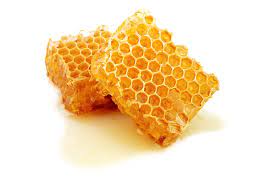THERAPEUTIC USAGE OF BEESWAX : COLLECTION & PROCESSING
Beeswax is the substance that is obtained from the structure of a honey comb. The bees secrete wax to build the honey combs to store honey. It has rich hydrophobic property, the beeswax is in fact present within cosmetics and body products. Also, beeswax is used in food industry. Beeswax is a complex mixture of hydrocarbons, free fatty acid, esters of fatty acid. Beeswax plays an important role in Ayurvedic medicine, the traditional medicine name with Madhushistha (Beewax). The Madhushistha is used for the care of wound from abrasion or even from burns with topical application. Some references in Ayurvedic granth highlight the use of Madhushistha in combination with other herbal and mineral mixture, like Sikta Taila, Mruddaharshringa, Jatyadi Taila, etc. Beeswax is mainly of two types, natural beeswax and processed beeswax. Natural beeswax is clarified further heating in water with petroleum waxes. Because of high demand and shortage in market, adulteration of beeswax with cheaper materials are common like animal fat, plant oil and petroleum spirits (Paraffin wax).
Beeswax (cera alba) is a natural wax produced by honey bees belonging to the genus Apis which forms the structure of a honeycomb. The purpose of secreting wax is to build honeycombs to store honey.
What is Beeswax
Beeswax (cera alba) is a natural wax produced by honey bees belonging to the genus Apis which forms the structure of a honeycomb. The purpose of secreting wax is to build honeycombs to store honey. It consists of around284 different compounds including a variety of elements but its exact composition varies with location.
The melting point of beeswax is over 140 ° Fahrenheit. The wax is secreted (in form of thin sheets called scales) from eight wax-producing glands present on the worker bee’s abdomen. The scales are clear, brittle, colorless, and tasteless.
Typically beeswax is produced by the younger house bees( between twelve and twenty days old ). As the bee starts growing older and begins to collect pollen and nectar, the wax-producing glands start to atrophy, but their ability to produce beeswax Isn’t losted completely. When bees starts swarming they rapidly produces wax comb, since they require a place for the queen to lay eggs and somewhere to store food.Around 1,100 scales are required to produce one gram of wax.
The three major beeswax products are –
- Yellow beeswax – crude product obtained from the honeycomb.
- White beeswax – is made from yellow beeswax by bleaching
- Beeswax absolute – made by treating yellow beeswax with alcohol.
Over time, bees have figured out that by building their combs into hexagon shape, the combs hold the maximum amount of honey and require the least amount of wax.
Benefits and usage of beeswax :
- Moisturises the skin
Commonly found in skincare products and cosmetics, beeswax is an amazing way to moisturize the skin. It helps in protecting and repairing rough, dry or chapped skin because of its ability to lock in moisture.
The wax is rich in vitamin A and emollient properties, that helps in softening and rehydrating the skin as well as assist in the healthy development of cells.
- Liver protection
According to a study, the alcohols found in honeycomb can help in protecting the liver because of their antioxidant effects.
It helps in normalizing liver function and improving symptoms of fatty liver.
- Lowers Cholesterol Levels
According to research long-chain fatty alcohols obtained from waxes can help in lowering cholesterol in humans. The regulatory effects of wax esters beeswax lower bad cholesterol by 21 percent to 29 percent and raise good cholesterol by 8 percent to 15 percent.
- Helps in treating psoriasis, eczema, and dermatitis
It is a great choice for many skin conditions. A mixture of honey, beeswax, and olive oil is useful in the treatment of diaper dermatitis, eczema, and psoriasis.
The honey mixtures could inhibit the growth of bacteria that may affect the skin and cause skin conditions.
- Anti-inflammatory and relieves pain
beeswax is effective in relieving pain and inflammation and has mild anti-swelling effects too.
- Clears Acne
Having strong antiseptic and healing properties, beeswax is a well-known home remedy for removing acne. It’s also an excellent skin softener that helps in maintaining a smooth skin texture after acne elimination.
- Heals dry lips
Beeswax is a perfect lip balm because of its natural moisturizing property. Topical applications of beeswax alone or with other ingredients like coconut oil, honey, etc. can give relief for dry lips.
- Treats Fungal skin infections
Beeswax can treat fungal skin infections as well as jock itch too because of its anti-inflammatory properties. It helps in reducing the pain associated with jock itch and fungal infections while providing moisturizing benefits to help reduce the itching.
Apply a mixture of beeswax, honey, and olive oil to the affected area three times daily for four weeks for best results.
- Reduces stretch marks
Beeswax has positive effects on those stretch marks due to its ability to protect the skin and retain water.
- Other uses
Beeswax is used in making candles and soaps, that are natural, have a soothing feel, and have a pleasant smell. White beeswax and beeswax absolute are used as stiffening agents in many foods and beverages while yellow and white beeswax are used as thickeners, emulsifiers, and stiffening agents in cosmetics in manufacturing.
Propolis- is a natural resinous product that is collected by bees from various plants and mixed with beeswax and salivary enzymes. Propolis is hard and breakable in cold temperatures but soft, flexible and sticky when warmed, so that it can be used to fill gaps, close holes and build the beehive. The sealant action of propolis protects the hive from microorganisms, spores and mold. Propolis has been used by humans topically for treatment of wounds, skin ulcers and rashes and in oral forms as therapy of diabetes, obesity, cancer and other conditions. Propolis is purported to have antiinflammatory, antioxidant, antidiabetic and even antineoplastic activity based upon studies in cell culture and animal models of diseases such as diabetes, obesity and cancer. None of these activities have been convincingly shown in humans with diabetes, obesity or cancer. In most clinical trials, adverse event rates have not been mentioned, but propolis is reported to be well tolerated. Propolis, like bee pollen, is highly variable with chemical compositions that differ markedly by genus of bees and geographic location (based upon local plant species). Propolis may contain contaminants, insect parts and allergens from the environment. Contact dermatitis from propolis is a well known complication of bee-keeping and can occur with topical and oral administration of propolis. Allergic reactions including angioedema and anaphylaxis from commercial sources of propolis have been reported. The allergic reactions are likely due to plant flavonoid aglycones.
Compiled & Shared by- Team, LITD (Livestock Institute of Training & Development)
Image-Courtesy-Google
Reference-On Request.
Bee Wax-Collection & Processing

Bee Wax-Collection & Processing


